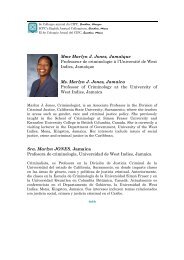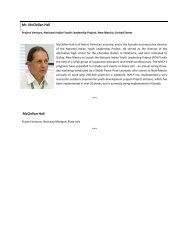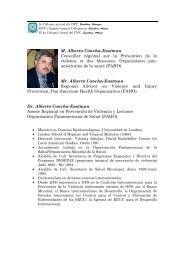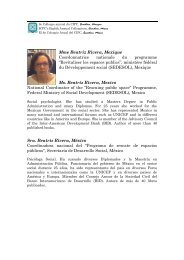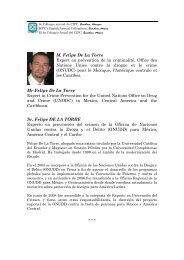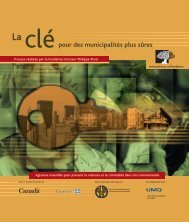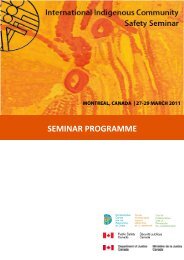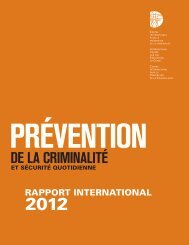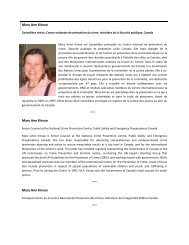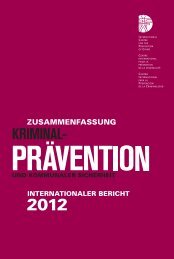Ms. Kalpana Viswanath - International Centre for the Prevention of ...
Ms. Kalpana Viswanath - International Centre for the Prevention of ...
Ms. Kalpana Viswanath - International Centre for the Prevention of ...
Create successful ePaper yourself
Turn your PDF publications into a flip-book with our unique Google optimized e-Paper software.
8e Colloque annuel du CIPC, Querétaro, MexiqueICPC’s Eighth Annual Colloquium, Querétaro, MexicoEl 8o Coloquio Anual del CIPC, Querétaro, MéxicoMme <strong>Kalpana</strong> <strong>Viswanath</strong>Secrétaire du comité exécutif, Jagori, IndeProjet JAGORI<strong>Ms</strong>. <strong>Kalpana</strong> <strong>Viswanath</strong>Secretary <strong>of</strong> <strong>the</strong> Executive Committee, JAGORI, IndiaProject JAGORI<strong>Kalpana</strong> <strong>Viswanath</strong> is researcher working on issues <strong>of</strong> women's safety. Sheholds a PhD in Sociology and has headed JAGORI, a women's resource centerin Delhi <strong>for</strong> several years till 2007. She has been involved in issues andcampaigns on violence against women <strong>for</strong> over 15 years. She has researchedand written on issues related to women's rights, women and migration,women workers and women's safety. She is currently <strong>the</strong> Project Director,Gender Inclusive Cities Project with Women in Cities <strong>International</strong>.Sra. <strong>Kalpana</strong> <strong>Viswanath</strong>Secretaria del Comité ejecutivo, JAGORI, IndiaProyecto JAGORI
8e Colloque annuel du CIPC, Querétaro, MexiqueICPC’s Eighth Annual Colloquium, Querétaro, MexicoEl 8o Coloquio Anual del CIPC, Querétaro, MéxicoSafe Delhi CampaignWomen’s Safety in Public Spaces in Delhi<strong>Kalpana</strong> <strong>Viswanath</strong>IntroductionIn this paper we examine <strong>the</strong> nature <strong>of</strong> gender usage and gendered violencein public spaces in <strong>the</strong> city <strong>of</strong> Delhi. We locate our work within <strong>the</strong> debates on<strong>the</strong> nature <strong>of</strong> violence against women and debates on <strong>the</strong> nature <strong>of</strong>contemporary urban spaces. We argue that cities are a particular <strong>for</strong>m <strong>of</strong>social life which allow <strong>for</strong> and encourage different understandings and usages<strong>of</strong> public spaces which are deeply gendered, both in access and right to publicspace.Delhi has <strong>the</strong> dubious distinction <strong>of</strong> being one <strong>of</strong> most unsafe cities in <strong>the</strong>world <strong>for</strong> women. Statistics show that women in Delhi are face more violencethan in any o<strong>the</strong>r city in this country. Delhi tops <strong>the</strong> list on all crimes againstwomen including molestation, rape, dowry harassment, domestic violence.According to <strong>the</strong> 2005 National Crime Records Bureau statistics, one third <strong>of</strong>all reported rapes in mega cities took place in Delhi. 1 Similarly, 23% <strong>of</strong> allreported molestation in mega cities took place in Delhi.In an ef<strong>for</strong>t to address <strong>the</strong> issues <strong>of</strong> lack <strong>of</strong> safety <strong>for</strong> women, JAGORIlaunched a campaign to bring into public focus <strong>the</strong> issue <strong>of</strong> women’s safety.The campaign aims are to highlight public safety <strong>for</strong> women as a seriousissue and to link increasing unsafety to dominant models <strong>of</strong> urbanisation and<strong>the</strong> culture <strong>of</strong> <strong>the</strong> city. The Safe Delhi Campaign has a multi-prongedapproach which includes research, public outreach, strategic partnershipsand communication initiatives among o<strong>the</strong>rs. As a first step to understand<strong>the</strong> extent and contours <strong>of</strong> <strong>the</strong> issue, Safety Audits were conducted indifferent parts <strong>of</strong> <strong>the</strong> city. These Safety Audits are aimed at identifyingfactors that cause insecurity and lack <strong>of</strong> safety and those that create a feeling<strong>of</strong> safety among women and girls.Safety <strong>of</strong> Women and urban spaces: The safety auditsWe adapted <strong>the</strong> Safety Audits methodology in particular ways to <strong>the</strong> locallevel. The focus <strong>of</strong> our audits in Delhi has been on both physicalinfrastructure and <strong>the</strong> usage <strong>of</strong> spaces. In addition we have also1 Mega cities are those with a population over one million
8e Colloque annuel du CIPC, Querétaro, MexiqueICPC’s Eighth Annual Colloquium, Querétaro, MexicoEl 8o Coloquio Anual del CIPC, Querétaro, Méxicosupplemented <strong>the</strong> data from our audits with in<strong>for</strong>mation collected throughfocus group discussions and a survey <strong>of</strong> women’s experiences <strong>of</strong> violence inpublic spaces.JAGORI conducted a series <strong>of</strong> Safety Audits across <strong>the</strong> city <strong>of</strong> Delhi during<strong>the</strong> period August 2005 – July 2006. The aim was to get a representativesample <strong>of</strong> diverse areas <strong>of</strong> <strong>the</strong> city. These audits were conducted inresidential colonies, resettlement areas, market places, commercial areas,educational campus, railway station and industrial area. They wereconducted by <strong>the</strong> members <strong>of</strong> JAGORI and in some areas along with localresidents and members <strong>of</strong> local organizations.We started <strong>the</strong> audits just be<strong>for</strong>e dark. The audit route was identified by <strong>the</strong>team and in certain places <strong>the</strong> team divided itself into small groups so as tocover a larger area. The issues we focused upon were:• The state <strong>of</strong> infrastructure or <strong>the</strong> built environment – streetlights, <strong>the</strong>state <strong>of</strong> pavements, bus stops, how tall are <strong>the</strong> trees, whe<strong>the</strong>r <strong>the</strong>ycover <strong>the</strong> streetlights, <strong>the</strong> maintenance <strong>of</strong> parks, dark/ abandonedbuildings or areas, <strong>the</strong> state <strong>of</strong> car parking area.• The location <strong>of</strong> police booths, public telephones, shops and o<strong>the</strong>rvendors. In <strong>the</strong> case <strong>of</strong> shops, we also noted <strong>the</strong> kind <strong>of</strong> shops as certainshops such as auto parts or liquor have primarily male customers.• The usage <strong>of</strong> space according to gender.• Women users perceptions <strong>of</strong> safety.Addressing infrastructure issues is one part <strong>of</strong> conducting a Safety Audit.These are <strong>the</strong> concrete and visible ways in which safety or unsafety isdetermined and which can be changed. In addition culture <strong>of</strong> <strong>the</strong> city plays acentral role in determining <strong>the</strong> usage <strong>of</strong> spaces. Public spaces in Delhi areprimarily male dominated spaces. Men can be seen out in most areas andduring most times. Women are legitimately allowed to use <strong>the</strong>se spaces when<strong>the</strong>y have a purpose to be <strong>the</strong>re. Thus, if <strong>the</strong>y are on <strong>the</strong>ir way to work orstudy, dropping or picking up children, walking in a park (at certain times),shopping (at certain times), <strong>the</strong>n <strong>the</strong>y are seen as legitimate users <strong>of</strong> <strong>the</strong>space. What women do not have is <strong>the</strong> license to just be or “hang around” inpublic spaces.Time is ano<strong>the</strong>r major factor in determining who can and should be in publicspaces. There are some times <strong>of</strong> <strong>the</strong> day when it is more acceptable <strong>for</strong>women to be seen and be users <strong>of</strong> public spaces. It is more unacceptable <strong>for</strong>women to be out after dark but we found that even during <strong>the</strong> daytime <strong>the</strong>reare spaces where women found difficult to access or uncom<strong>for</strong>table tonavigate.
8e Colloque annuel du CIPC, Querétaro, MexiqueICPC’s Eighth Annual Colloquium, Querétaro, MexicoEl 8o Coloquio Anual del CIPC, Querétaro, MéxicoWe recognize that gender is not <strong>the</strong> only or even primary axis <strong>of</strong>discrimination in urban spaces. Age, social class, occupation, marital statusare o<strong>the</strong>r identities which impact <strong>of</strong> <strong>the</strong> experience <strong>of</strong> urban spaces. Class andprivilege are central to people’s definition <strong>of</strong> <strong>the</strong>ir experience in cities. Ourresearch and data show that an overwhelming majority <strong>of</strong> women in this cityface violence or fear <strong>the</strong> possibility <strong>of</strong> violence and <strong>the</strong>re<strong>for</strong>e structure <strong>the</strong>irmovements. In a survey carried out by JAGORI <strong>of</strong> 500 women in <strong>the</strong> city,over 95% reported carrying an object <strong>for</strong> self protection such as pepper spraysand sharp objects; or restricting <strong>the</strong>ir movements both in terms <strong>of</strong> space andtime; or dressing in a certain way in order to feel more com<strong>for</strong>table while inpublic spaces.Findings from safety audits: Infrastructure Issues and usage <strong>of</strong> spaceThe audits conducted by us in different areas <strong>of</strong> Delhi revealed manyinfrastructure inconsistencies. First, lighting in public spaces emerged as aproblem in many parts <strong>of</strong> <strong>the</strong> city. We found that poorly lit areas such asmain roads, inner streets, sections <strong>of</strong> markets, area between residentialblocks, bus stops, public toilets, subways, parks and car parks pose a threatto <strong>the</strong> safety <strong>of</strong> women.Women we spoke with shared that <strong>the</strong>y avoid such places after dark as <strong>the</strong>yhave ei<strong>the</strong>r been harassed in <strong>the</strong>se spaces or that <strong>the</strong>y are apprehensive <strong>of</strong>violence. Ei<strong>the</strong>r way, this curtails <strong>the</strong>ir movement. To begin with, weobserved that <strong>the</strong> lights on <strong>the</strong> roads are <strong>of</strong>ten placed on <strong>the</strong> center <strong>of</strong> <strong>the</strong>road or only on one side <strong>of</strong> <strong>the</strong> road with <strong>the</strong> light reaching only <strong>the</strong> road andnot on both sides <strong>of</strong> <strong>the</strong> pavements. Fur<strong>the</strong>r, <strong>the</strong> bus stops are primarily lit bystreetlights and have no lights <strong>of</strong> <strong>the</strong>ir own. Thus, only those bus stops whichare close to streetlights are well lit.We observed that <strong>the</strong> number <strong>of</strong> women on bus stops in all parts <strong>of</strong> <strong>the</strong> cityreduces as <strong>the</strong> evening progresses and very few lone women are present atstops after dark. But women pointed out that <strong>the</strong>y feel safer on bus stopsthan on <strong>the</strong> road and prefer to wait <strong>for</strong> auto rickshaws or <strong>for</strong> <strong>the</strong>ir friends atbus stops than on <strong>the</strong> roadside. If <strong>the</strong>y are alone, even if it is not a very welllit place, women find <strong>the</strong> bus stop to be a legitimate space to be in after dark.In o<strong>the</strong>r places women described <strong>the</strong> problems faced by walking on darkroads and inner colony streets. Women fear that men would accost <strong>the</strong>m in<strong>the</strong> dark while walking to <strong>the</strong> bus stop or walking home from <strong>the</strong> stop. Incertain residential areas, <strong>the</strong> bus stop and sections <strong>of</strong> <strong>the</strong> road leading to <strong>the</strong>block are dimly lit and women <strong>of</strong>ten face verbal harassment. Streetlights and
8e Colloque annuel du CIPC, Querétaro, MexiqueICPC’s Eighth Annual Colloquium, Querétaro, MexicoEl 8o Coloquio Anual del CIPC, Querétaro, Méxicoo<strong>the</strong>r <strong>for</strong>ms <strong>of</strong> lighting in commercial and educational areas have differentimplications than in residential areas. Women’s ability to work late at <strong>of</strong>ficesor in libraries is curtailed, as <strong>the</strong>y feel threatened once <strong>the</strong>y step out <strong>of</strong> <strong>the</strong>irworkplace.We found that women feel uncom<strong>for</strong>table in male dominated spaces such ascigarette shops, dhabas (roadside tea and food stalls), taxi stands, certainstreet corners, helmet stands in car parks, liquor shops, and certain parks.Women not only hesitate to use any<strong>of</strong> <strong>the</strong>se spaces but also are reluctant to be present near <strong>the</strong>m <strong>for</strong> <strong>the</strong> fear <strong>of</strong>harassment.During <strong>the</strong> course <strong>of</strong> <strong>the</strong> audits conducted over a yearlong period, parks wereone <strong>of</strong> <strong>the</strong> most striking spaces used differently by men and women. Lightingwas again <strong>the</strong> main area <strong>of</strong> concern as lights were <strong>of</strong>ten hidden by <strong>the</strong> treesin some parks while in some o<strong>the</strong>r parks <strong>the</strong>y were not working.Pedestrian subways are becoming a regular feature <strong>of</strong> Delhi’s topography. Wefound that most subways are well lit, though <strong>of</strong>ten not at <strong>the</strong> entry/exitpoints. Fur<strong>the</strong>r, <strong>the</strong> signage at some <strong>of</strong> <strong>the</strong>se points are not clear. Most <strong>of</strong> <strong>the</strong>subways do not have guards or attendants and we felt unsafe using <strong>the</strong>m latein <strong>the</strong> evening when <strong>the</strong> number <strong>of</strong> users rapidly declines. Some subways,that have a few shops which are open till <strong>the</strong> closure time <strong>of</strong> <strong>the</strong> subway.Regular women users <strong>of</strong> <strong>the</strong> subway shared that <strong>the</strong>y felt safe using it evenafter dark because <strong>of</strong> <strong>the</strong> presence <strong>of</strong> <strong>the</strong> shopkeepers over a period <strong>of</strong> time.Women reported feeling safe to move around after dark because <strong>of</strong> <strong>the</strong>presence <strong>of</strong> familiar vendors selling vegetables and o<strong>the</strong>r household items,<strong>the</strong> local ironing person and o<strong>the</strong>rs who are regularly present till late in <strong>the</strong>evening. They also felt safe walking around local night markets, especially<strong>the</strong> weekly evening markets.Safe Delhi CampaignFollowing <strong>the</strong> safety audits, several interventions and public interactionsfollowed.Public outreachThe aim was to reach out to <strong>the</strong> “man” and “woman” on <strong>the</strong> road tounderstand <strong>the</strong>ir experiences and share our campaign materials. Thisincluded regular interactions between <strong>the</strong> campaign team and <strong>the</strong> public.One day every month was dedicated to choosing one area in <strong>the</strong> city andmoving around with campaign materials and speaking to people. In addition,campaign materials including a helpline booklet (with all important numbers
8e Colloque annuel du CIPC, Querétaro, MexiqueICPC’s Eighth Annual Colloquium, Querétaro, MexicoEl 8o Coloquio Anual del CIPC, Querétaro, Méxicoin <strong>the</strong> city) were distributed through different channels including cafes,beauty parlours, shops, educational institutions, shopping areas etc.Ano<strong>the</strong>r method was a bus rally through <strong>the</strong> city with bright banners andmusic with stopovers at markets and o<strong>the</strong>r public places. Jagori along withfriends also participated in <strong>the</strong> Great Delhi Run in large numbers as asymbolic claim to public spaces.Creating partnershipsSeveral types <strong>of</strong> partnerships were created during this campaign.• CII, an industry body to conduct sessions on Sexual harassment at <strong>the</strong>workplace.• With PEHEL, a group <strong>of</strong> teachers and students in Delhi University• With <strong>the</strong> South Delhi Auto Union to carry public services messages onwomen’s safety on <strong>the</strong>ir vehicles.• With <strong>the</strong> Delhi Transport Corporation to sensitise driver andconductors to issues <strong>of</strong> women’s safety. This was done with over 3000personnel.Using different media• This campaign has been an interesting experience <strong>for</strong> us to work with<strong>the</strong> online medium to reach out to people especially younger peoplewho are familiar with <strong>the</strong> medium. It involved creating an interactivewebsite where many people wrote in. We had between 450-700 hits amonth.• A mailing list <strong>of</strong> over 700 individuals and groups• Ad spot “Staring Hurts” on youtube. Almost 10,000 people have viewedit online.
Creating Safer CitiesWorking with women and communitiesSafe Delhi Campaign: Working toge<strong>the</strong>r to make Delhi violence-free <strong>for</strong> women and girls
Aims <strong>of</strong> <strong>the</strong> CampaignTo understand what “safety” means to women and girls ando<strong>the</strong>r vulnerable groupsTo work towards creating a society free <strong>of</strong> violence and fearTo ensure that women are integrally involved in this process.To broaden <strong>the</strong> issue beyond a “women’s issue” and make <strong>the</strong>whole society responsible <strong>for</strong> safety and addressing violenceagainst womenSafe Delhi Campaign: Working toge<strong>the</strong>r to make Delhi violence-free <strong>for</strong> women and girls
StrategiesConducting Safety Audits to map out safety factors in <strong>the</strong> cityMobilising public opinion to get people to speak out on violenceagainst womenWorking in partnership with <strong>the</strong> police and administration to ensurethat urban planning and law en<strong>for</strong>cement create <strong>the</strong> conditions <strong>for</strong>safety.Building partnerships with diverse constituencies governmentagencies, civil il society groups, NGOs, educational institutions, privatesector bodies, citizens’ groups to implement innovative strategies tomake <strong>the</strong> city safe.Safe Delhi Campaign: Working toge<strong>the</strong>r to make Delhi violence-free <strong>for</strong> women and girls
Research MethodologyFocus group discussions with different sections <strong>of</strong> people tounderstand usage <strong>of</strong> and com<strong>for</strong>t with public spaces - youngmen, young women, older women, girls and women inresettlement areas, domestic workersSafety audits in 20 areas <strong>of</strong> <strong>the</strong> citySurvey on 500 women in <strong>the</strong> city to understand patterns <strong>of</strong> use<strong>of</strong> public spaces and vulnerabilitiesSafe Delhi Campaign: Working toge<strong>the</strong>r to make Delhi violence-free <strong>for</strong> women and girls
Safety Audits in DelhiMethodology to identify factors leading to safety or lack <strong>of</strong> safety.Conducted 25 audits in residential areas, resettlement colonies,markets, university, railway stationMeetings with people living/using <strong>the</strong> spacesTalking to people to get perceptions <strong>of</strong> safetyInvolving community in audits- liased with RWA’s in several areas.Safe Delhi Campaign: Working toge<strong>the</strong>r to make Delhi violence-free <strong>for</strong> women and girls
Questions asked in <strong>the</strong> AuditsWhen do you feel uncom<strong>for</strong>table in a place?Have you heard or experienced anything negative here?Would anyone be able to hear if you called <strong>for</strong> help?Would people help if you were in need?What kind <strong>of</strong> changes would make you feel safer?Who do you think can play a role in addressing safety?Safe Delhi Campaign: Working toge<strong>the</strong>r to make Delhi violence-free <strong>for</strong> women and girls
Observations from Safety Audits- ResidentialStreet lighting very unevenPavements ae ets– unclean, broken, overgrown o trees,unusableSignagegParksBus stopsGarbage dumpsDark areasBoundary wallsSafe Delhi Campaign: Working toge<strong>the</strong>r to make Delhi violence-free <strong>for</strong> women and girls
No place to walk !Safe Delhi Campaign: Working toge<strong>the</strong>r to make Delhi violence-free <strong>for</strong> women and girls
Public park in Mayur Vihar with no lights.Safe Delhi Campaign: Working toge<strong>the</strong>r to make Delhi violence-free <strong>for</strong> women and girls
Observations – Markets/Public SpacesBus stopsSubwaysPublic toiletsCar parksVacant plotsLightingSafe Delhi Campaign: Working toge<strong>the</strong>r to make Delhi violence-free <strong>for</strong> women and girls
Factors Affecting SafetyPhysical factors such as lighting, signagePublic spaces - male dominatedTrivialising <strong>of</strong> sexual harassmentLack <strong>of</strong> public supportBurden <strong>of</strong> safety put upon womenSafe Delhi Campaign: Working toge<strong>the</strong>r to make Delhi violence-free <strong>for</strong> women and girls
IssuesDifferent contexts produce different notions – middle classneighborhoods, slumsIntersection <strong>of</strong> marginalised identities.How lack <strong>of</strong> safety structures women’s and girls livesHow to address different sets <strong>of</strong> actorsSafe Delhi Campaign: Working toge<strong>the</strong>r to make Delhi violence-free <strong>for</strong> women and girls
SaketSafe Delhi Campaign: Working toge<strong>the</strong>r to make Delhi violence-free <strong>for</strong> women and girls
Connaught PlaceSafe Delhi Campaign: Working toge<strong>the</strong>r to make Delhi violence-free <strong>for</strong> women and girls
Interventions and strategiesPublic interactionsCommunity actions and organisingAwareness materials and using mass mediaWorking with institutionsSafe Delhi onlineSafe Delhi Campaign: Working toge<strong>the</strong>r to make Delhi violence-free <strong>for</strong> women and girls
Safe Delhi Campaign: Working toge<strong>the</strong>r to make Delhi violence-free <strong>for</strong> women and girls
Public OutreachOver 40,000 helpline booklets distributedthrough movie <strong>the</strong>atres, cafes.shops, beauty parlours,direct distribution.CityBus rally through parts <strong>of</strong>Meeting and talking topublicSafe Delhi Campaign: Working toge<strong>the</strong>r to make Delhi violence-free <strong>for</strong> women and girls
Safe Delhi Campaign: Working toge<strong>the</strong>r to make Delhi violence-free <strong>for</strong> women and girls
Safe Delhi Campaign: Working toge<strong>the</strong>r to make Delhi violence-free <strong>for</strong> women and girls
Campaign MaterialBannersSafe Delhi Campaign: Working toge<strong>the</strong>r to make Delhi violence-free <strong>for</strong> women and girls
Community organisingCommunity women’s and youth groups created intwo lower income areasDeal with crime and violence against women at <strong>the</strong>local level.Work with police to demand <strong>the</strong>ir rightsCommunity awareness and mobilisation.Safe Delhi Campaign: Working toge<strong>the</strong>r to make Delhi violence-free <strong>for</strong> women and girls
Auto Drivers Join <strong>the</strong> DrivePartnership with SouthDelhi Auto Union todisplay 5,000 stickerson <strong>the</strong> back <strong>of</strong> autos.Interaction with autodrivers.Safe Delhi Campaign: Working toge<strong>the</strong>r to make Delhi violence-free <strong>for</strong> women and girls
Working with Transport CorporationSafe Delhi Campaign: Working toge<strong>the</strong>r to make Delhi violence-free <strong>for</strong> women and girls
Safe Delhi OnlineSafe Delhi website launched in Oct2006Approximately 400-750 visits a month.Many responses ses from users. s700 people have registered on <strong>the</strong>mailing listOf this 100 are media peopleStaring Hurts ad on youtube.comOver 10,000 views as <strong>of</strong> June 2008Safe Delhi Campaign: Working toge<strong>the</strong>r to make Delhi violence-free <strong>for</strong> women and girls
Safe Delhi Campaign: Working toge<strong>the</strong>r to make Delhi violence-free <strong>for</strong> women and girls




